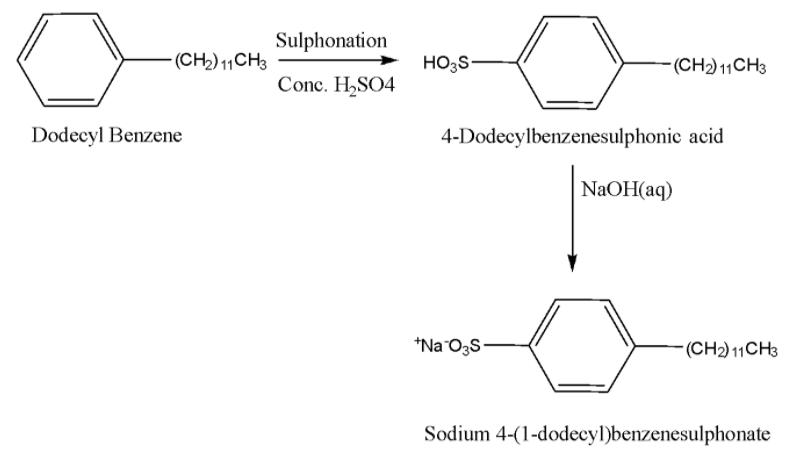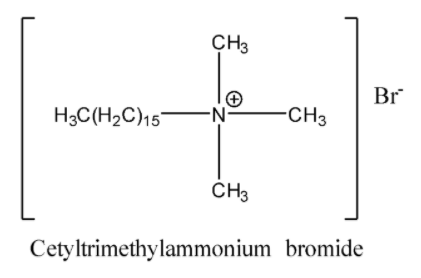
Answer
465.3k+ views
Hint: Detergents are surfactants. Like soap, they also have hydrophobic and hydrophilic parts. They are classified as cationic, anionic and non-ionic detergents based on the charge carried by the bigger portion of the detergent molecule which is also responsible for cleansing action of the detergent.
Complete step-by-step answer:
First let us understand about detergents. Detergents are similar to soaps but their chemical structures are different. Detergents are generally ammonium, sulfate or sulphate salts of long chain hydrocarbons (containing 12-18 carbon atoms). A detergent has both hydrophobic and hydrophilic parts. If we are using hard water for cleaning purposes, it is better to use detergents than using soap. Hard water is composed of calcium and magnesium ions. So if we use soap with hard water, it will lead in the formation of ‘scum’ but the calcium and magnesium salts of detergents are soluble in water and hence no scum is formed.
Based on the electrical charge, detergents are classified as:
(a) Anionic detergents: Detergents in which a large portion of the molecule carries a negative charge i.e. it is an anion and is responsible for the cleansing action, such detergents are called anionic detergents. They are of two types:
-Sodium Alkyl Sulphates: They are prepared from long straight chain alcohols (containing 12-18 carbon atoms) which are treated with concentrated sulphuric acid followed by an alkali such as NaOH. Example: sodium lauryl sulphate. Its preparation is given below:
$ \begin{matrix} { C }_{ 11 }{ H }_{ 23 }{ CH }_{ 2 }OH \\ Lauryl\quad alcohol \end{matrix}\xrightarrow { Conc.\quad { H }_{ 2 }{ SO }_{ 4 } } \begin{matrix} { C }_{ 11 }{ H }_{ 23 }{ CH }_{ 2 }O{ SO }_{ 3 }H \\ Lauryl\quad hydrogen\quad sulphate\quad \end{matrix}$
$ \begin{matrix} { C }_{ 11 }{ H }_{ 23 }{ CH }_{ 2 }O{ SO }_{ 3 }H \\ Lauryl\quad hydrogen\quad sulphate \end{matrix}\xrightarrow { NaOH } \begin{matrix} { C }_{ 11 }{ H }_{ 23 }{ CH }_{ 2 }{ OSO }_{ 3 }^{ - }{ Na }^{ + } \\ Sodium\quad lauryl\quad sulphate \end{matrix}$
-Sodium alkylbenzene sulphonates: They are sodium salts of long chain alkyl benzene sulphonic acids. They are prepared by Friedel-Crafts alkylation of benzene using long chain alkyl halide/alkene/alcohol followed by sulphonation and neutralization using an alkali such as NaOH. Example: 4-(1-dodecyl)benzenesulfonate (SDS). Its preparation is given below:

(b) Cationic Detergents: Detergents in which a large portion of the molecule carries a positive charge i.e. it is a cation and is responsible for the cleansing action, such detergents are called cationic detergents. They consist of quaternary ammonium salts containing one or more long chain alkyl groups. They are used as germicides and as ingredients in shampoos and conditioners. Example: cetyltrimethylammonium bromide.

(c) Non-ionic detergents: They do not consist of any ion. They are esters of high molecular weight alcohols. They can be prepared by treating long chain alcohols with excess of ethylene oxide in the presence of a base. Example: Lauryl alcohol ethoxylate. The reaction is given below:

Hence cationic, anionic and non-ionic detergents are explained.
Note: Detergents have many advantages over soaps. However they are not completely biodegradable while soaps are completely biodegradable. This is due to the presence of highly branched hydrocarbon chains in detergents due to which bacteria are not able to decompose them.
Complete step-by-step answer:
First let us understand about detergents. Detergents are similar to soaps but their chemical structures are different. Detergents are generally ammonium, sulfate or sulphate salts of long chain hydrocarbons (containing 12-18 carbon atoms). A detergent has both hydrophobic and hydrophilic parts. If we are using hard water for cleaning purposes, it is better to use detergents than using soap. Hard water is composed of calcium and magnesium ions. So if we use soap with hard water, it will lead in the formation of ‘scum’ but the calcium and magnesium salts of detergents are soluble in water and hence no scum is formed.
Based on the electrical charge, detergents are classified as:
(a) Anionic detergents: Detergents in which a large portion of the molecule carries a negative charge i.e. it is an anion and is responsible for the cleansing action, such detergents are called anionic detergents. They are of two types:
-Sodium Alkyl Sulphates: They are prepared from long straight chain alcohols (containing 12-18 carbon atoms) which are treated with concentrated sulphuric acid followed by an alkali such as NaOH. Example: sodium lauryl sulphate. Its preparation is given below:
$ \begin{matrix} { C }_{ 11 }{ H }_{ 23 }{ CH }_{ 2 }OH \\ Lauryl\quad alcohol \end{matrix}\xrightarrow { Conc.\quad { H }_{ 2 }{ SO }_{ 4 } } \begin{matrix} { C }_{ 11 }{ H }_{ 23 }{ CH }_{ 2 }O{ SO }_{ 3 }H \\ Lauryl\quad hydrogen\quad sulphate\quad \end{matrix}$
$ \begin{matrix} { C }_{ 11 }{ H }_{ 23 }{ CH }_{ 2 }O{ SO }_{ 3 }H \\ Lauryl\quad hydrogen\quad sulphate \end{matrix}\xrightarrow { NaOH } \begin{matrix} { C }_{ 11 }{ H }_{ 23 }{ CH }_{ 2 }{ OSO }_{ 3 }^{ - }{ Na }^{ + } \\ Sodium\quad lauryl\quad sulphate \end{matrix}$
-Sodium alkylbenzene sulphonates: They are sodium salts of long chain alkyl benzene sulphonic acids. They are prepared by Friedel-Crafts alkylation of benzene using long chain alkyl halide/alkene/alcohol followed by sulphonation and neutralization using an alkali such as NaOH. Example: 4-(1-dodecyl)benzenesulfonate (SDS). Its preparation is given below:

(b) Cationic Detergents: Detergents in which a large portion of the molecule carries a positive charge i.e. it is a cation and is responsible for the cleansing action, such detergents are called cationic detergents. They consist of quaternary ammonium salts containing one or more long chain alkyl groups. They are used as germicides and as ingredients in shampoos and conditioners. Example: cetyltrimethylammonium bromide.

(c) Non-ionic detergents: They do not consist of any ion. They are esters of high molecular weight alcohols. They can be prepared by treating long chain alcohols with excess of ethylene oxide in the presence of a base. Example: Lauryl alcohol ethoxylate. The reaction is given below:

Hence cationic, anionic and non-ionic detergents are explained.
Note: Detergents have many advantages over soaps. However they are not completely biodegradable while soaps are completely biodegradable. This is due to the presence of highly branched hydrocarbon chains in detergents due to which bacteria are not able to decompose them.
Recently Updated Pages
Identify the feminine gender noun from the given sentence class 10 english CBSE

Your club organized a blood donation camp in your city class 10 english CBSE

Choose the correct meaning of the idiomphrase from class 10 english CBSE

Identify the neuter gender noun from the given sentence class 10 english CBSE

Choose the word which best expresses the meaning of class 10 english CBSE

Choose the word which is closest to the opposite in class 10 english CBSE

Trending doubts
Which are the Top 10 Largest Countries of the World?

Fill the blanks with the suitable prepositions 1 The class 9 english CBSE

How do you graph the function fx 4x class 9 maths CBSE

Give 10 examples for herbs , shrubs , climbers , creepers

Change the following sentences into negative and interrogative class 10 english CBSE

Difference between Prokaryotic cell and Eukaryotic class 11 biology CBSE

The Equation xxx + 2 is Satisfied when x is Equal to Class 10 Maths

Write a letter to the principal requesting him to grant class 10 english CBSE

What organs are located on the left side of your body class 11 biology CBSE




